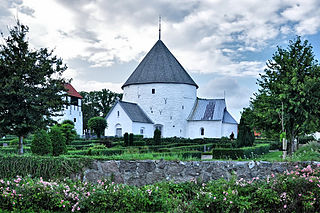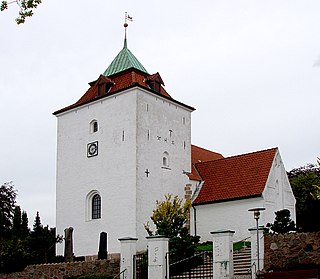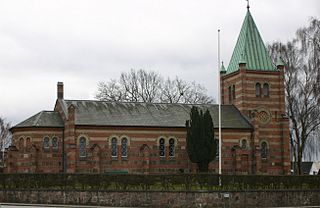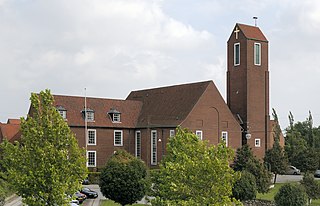
Budolfi Church is the cathedral church for the Lutheran Diocese of Aalborg in north Jutland, Denmark.

The Holmen Church is a Parish church in central Copenhagen in Denmark, on the street called Holmens Kanal. First built as an anchor forge in 1563, it was converted into a naval church by Christian IV. It is famous for having hosted the wedding between Margrethe II of Denmark, queen of Denmark between 1972 and 2024, and Prince Henrik in 1967. It is the burial site of such notabilities as naval heroes Niels Juel and Peter Tordenskjold, and composer Niels Wilhelm Gade, and contains artwork by, among others, Bertel Thorvaldsen and Karel van Mander.

Christian's Church is a Rococo church in the Christianshavn district of Copenhagen, Denmark. Designed by Nicolai Eigtved, it was built 1754–59.

The Church of Our Lady is a historical building at Kalundborg in northwestern Zealand, Denmark. The precise date of construction is not known with any certainty, though its architecture indicates the early part of the 13th century. With its five distinctive towers, it stands on a hill above the harbour, making it the town's most imposing landmark.

Skien Church is a parish church of the Church of Norway in Skien Municipality in Vestfold og Telemark county, Norway. It is located in the town of Skien. It is the church for the Skien parish which is part of the Skien prosti (deanery) in the Diocese of Agder og Telemark. The red brick church was built in a cruciform design in 1894 using plans drawn up by the architect Hagbarth Martin Schytte-Berg. The church seats about 1,050 people.

Svaneke Church is located in the small town of Svaneke on the Danish island of Bornholm. It stands above the harbour at a height of 18 metres on the site of a small chapel which appears to have existed for quite some time before the town received its charter in the 16th century. The church was expanded over the years, the tower and spire being completed in 1789. In 1881, virtually the whole building was rebuilt by architect Mathias Bidstrup of Rønne, leaving only the tower and a small section of the south wall.

Nylars Church is a 12th-century round church in the village of Nylars near Rønne in the south of the Danish island of Bornholm. Originally designed for a defensive role, the solid structure contains a series of 13th-century frescos, the oldest of Bornholm's four round churches.

Stubbekøbing Church is located in Stubbekøbing some 18 km (11 mi) northeast of Nørre Alslev on the Danish island of Falster. The basilical nave was built of limestone in the Late Romanesque period. Choir and tower are of brick, the choir built in Early Gothic style, tower and the northern chapels in the 15th century in Late Gothic style. In addition to its Renaissance altarpiece and pulpit, it has a variety of old frescos and wall decorations (1300–1500).

St Paul's Church is a parish church in Aarhus, Denmark. It was completed in 1887 to a design by Vilhelm Theodor Walther in the Neo-Romanesque style.

Undløse Church is located in the village of Undløse some 17 km (11 mi) southwest of Holbæk in northern Zealand, Denmark. The original part of the Romanesque church derives from the late 12th century. The church is noted for its early 15th-century frescoes and for its elaborate Baroque altarpiece and pulpit, both woodcuts by Abel Schrøder.

Hover Church is located approximately 2 kilometres (1.2 mi) west of the village of Hover in Ringkøbing-Skjern Municipality, Denmark. Built in twelfth century, it is one of Denmark's oldest stone churches. Not much has changed in its shape and appearance over the past 800 years, making it a good example of old Danish architecture. Hover Church is included within the Danish Culture Canon in the Architecture category.

Faxe Church is a Danish church located in the Diocese of Roskilde, in Faxe, Region Sjælland on the island of Zealand. It was built at the end of the 15th century on a site where there had originally been a Romanesque church. A number of frescos, probably painted by artists from the Brarup workshop, have been uncovered on the cross vaults, most recently above the organ.

Nakskov Church is the largest church in Nakskov on the west coast of the Danish island of Lolland. As Nakskov was mentioned in Valdemar's Census Book in the 13th century, the church probably dates to the same period.

Gloslunde Church is a Romanesque church east of Dannemare, some 13 km (8.1 mi) southeast of Nakskov on the Danish island of Lolland. Now whitewashed, it was built of red brick in the 13th century. The heritage listed Gloslunde Rectory is located next to the church.

St Martin's Church is a red brick church in Randers in the north of Jutland, Denmark. It was built from 1494 to 1520 on the site of an earlier church which was first mentioned in 1346.

Viby Church is a church located in Viby Parish in Aarhus, Denmark. The church is situated in the neighbourhood Viby, west of Marselisborg. It is a parish church which belongs to the Church of Denmark and there's population of 8.211 within the parish borders (2015).

Åby Church is a church located in Åby Parish in Aarhus, Denmark. The church is situated in the neighbourhood Åbyhøj, west of Midtbyen. The church is today a parish church in the Church of Denmark, serving a parish population of 10.925 (2015). The Åby Church pastorate is shared with the Åbyhøj Church to the north.

St. Mark's Church is a church located in St. Mark's Parish in Aarhus, Denmark. The church is located in the Midtbyen neighbourhood. It is a parish church within the Church of Denmark servicing a parish population of 8.873 (2015). The church was designed by the Danish architect Thomas Havning who won a public contest for a new church design in 1933. The parish of the Church of Our Lady was reaching a population of 10.000 and it had been decided to split it and create a new parish, requiring a new church. Construction began in 1934 and was completed in October, 1935. The church is dedicated to Mark the Evangelist. In 1982 a new wing, Klostergården, was added to the church with an office and recreational facilities for youth preparing for confirmation. In 1998 the church was extensively renovated.

Østbirk Church is a parish church in Horsens Municipality. It is overseen by the Diocese of Aarhus in the Church of Denmark.

Saint Peter's Church is a Lutheran church located in the center of Slagelse, Denmark. The congregation was originally part of the Roman Catholic Church, but was converted to Lutheranism during the Reformation.

























